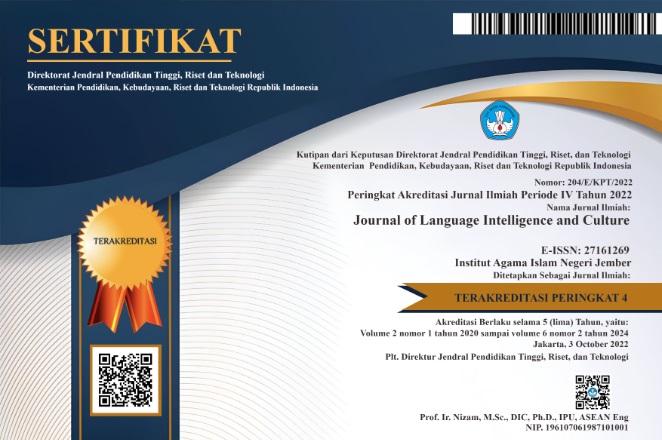Video Based Learning as a Media for Teaching English during Pandemic Covid-19
DOI:
https://doi.org/10.35719/jlic.v3i1.53Keywords:
Video Based Learning, Media, Pandemic Covid-19, English Language TeachingAbstract
The COVID-19 pandemic has stopped face-to-face learning in schools and switched to using online learning. This study aims to find out the use of video based learning in teaching English in schools during the COVID-19 pandemic. This study used the literature method by collecting and conducting in-depth literature studies. In various studies they were stated that learning by videos have been proven to be able to help teachers and students effectively in encouraging the development of new strategy in the classroom. The result of the study shows that the use of video as a media in English learning has a positive effect and can improve cognitive abilities, learning performances, developing interests, motivation and better understanding of the concept of the lesson being taught.
References
Atmojo, A. E. P., & Nugroho, A. (2020). EFL Classes Must Go Online! Teaching Activities and Challenges during COVID-19 Pandemic in Indonesia. Register Journal, 13(1), 49–76. https://doi.org/10.18326/rgt.v13i1.49-76
Bal-Gezegin, B. (2014). An investigation of using video vs. audio for teaching vocabulary. Procedia-Social and Behavioral Sciences, 143, 450-457.
Basilaia, G., & Kvavadze, D. (2020). Transition to Online Education in Schools during a SARS-CoV-2 Coronavirus (COVID-19) Pandemic in Georgia. Pedagogical Research, 5(4). https://doi.org/10.29333/pr/7937.
Berk, R. A. (2009). Multimedia teaching with video clips: TV, movies, YouTube, and mtvU in the college classroom. International Journal of Technology in Teaching & Learning, 5 (1), 1 – 21.
Chan, L. K., Patil, N. G., Chen, J. Y., Lam, J. C., Lau, C. S., & Ip, M. S. (2010). Advantages of video trigger in problem-based learning. Medical teacher, 32(9), 760-765.
Daniel, S. J. (2020). Education and the COVID-19 pandemic. PROSPECTS. https://doi.org/10.1007/s11125-020-09464-3.
Hadijah, S. (2016). Teaching by using video: Ways to make it more meaningful in EFL classrooms. Proceedings of ISELT FBS Universitas Negeri Padang, 4(2), 307-315.
Herron, C., Cole, S. P., Corrie, C., & Dubreil, S. (1999). The effectiveness of a video?based curriculum in teaching culture. The Modern Language Journal, 83(4), 518-533.
Irawati, D. (2016). Supporting student’s English speaking achievement using Video. IJEFL, 1(1), 45-60.
Lopez-Alvarado, J. (2017). Teaching English using video materials: design and delivery of a practical course. International Journal of Research and Education, 2(3), 1.
Matijevi?, M. (2014). Learning in the e - environment: New media and learning for the future. Libellarium, 7(1), 93-103.
McNulty, A., & Lazarevic, B. (2012). Best practices in using video technology to promote second language acquisition. Teaching English with technology, 12(3), 49-61.
Milosevic, D. (2017). Using video materials in English for technical sciences: a case study. New developments in ESP teaching and learning research, 15-30.
Prayudha. S, Joko. (2021). Students’ Problems Face In Online Learning Amidt Pandemic Covid-19. Acitya: Journal of Teaching & Education.
Prayudha.S, Joko. (2021). Efektivitas Komunikasi Terhadap Proses Belajar dalam Pembelajaran Online. Dawuh: Dakwah & Communication Islamic Journal. 2(1), P.33-40.
Reimers, F. (2020). Supporting the Continuation of Teaching and Learning During Covid 19 Pandemic. OECD Journal.
Reychav, I. & Wu, D. 2015. Mobile Collaborative Learning: The Role of Individual Learning in Groups Through Text and Video Content Delivery in Tablets: Journal Computers in Human Behavior.50(4: 520-534.
Ronchetti, M. (2010). Using Lecture Video Makes Lessons More Interactive: Journal Teacher Education. 5(2): 45-58.
Routarinne, S. & Ylirisku, S. 2012. Video Card Game as a Learning Design for Teacher Education: Journal Social and Behaviour Science. 45(6): 370-380.
Sabli?, M., Mirosavljevi?, A., & Škugor, A. (2020). Video-based learning (VBL)—past, present and future: An overview of the research published from 2008 to 2019. Technology, Knowledge and Learning, 1-17.
Shih, R. C. (2010). Blended learning using video-based blogs: Public speaking for English as a second language students. Australasian Journal of Educational Technology, 26(6).
Sihem, M. S. (2013). Using video techniques to develop students’ speaking skill (Master's thesis).
Spence, I. & Feng, J. 2010. Video Games and Spatial Cognition: Journal American Psychological Association. 14(2): 110-121.
Stempleski, S., & Arcario, P. (1992). Video in Second Language Teaching: Using, Selecting, and Producing Video for the Classroom. Teachers of English to Speakers of Other Languages (TESOL), Inc., 1600 Cameron St., Suite 300, Alexandria, VA 22314.
Stern, J. (2018). Introduction to Online Teaching and Learning. International Journal of Science Education, 3, 1–10. https://doi.org/10.1002/9781118784235.eeltv06b
Wamnebo, W., Hanapi, H., Bugis, R., & Handayani, N. (2018). Students’ Speaking Skill in Oral Descriptive Text by Using Video at Tenth Grade in SMA Negeri 1 Namlea. Jurnal Jupiter, 16(2), 98.
Williams, R. T., & Lutes, P. (2007). Using video in the ESL classroom. Takamatsu University Journal, 48, 1-13.
Downloads
Published
How to Cite
Issue
Section
License
Copyright (c) 2021 Journal of Language Intelligence and Culture

This work is licensed under a Creative Commons Attribution-ShareAlike 4.0 International License.













